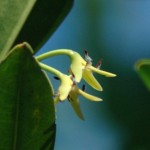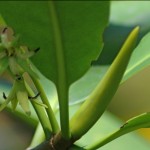Day one of the Coastal ecosystems module (click here if you don’t know what that means) was a good one, although I was very tired at the start of it. For some reason 6-month-olds just don’t care that you have to get up early in the morning. They’re on their own schedule, and everyone else can simply lump it, as far as they’re concerned.
What I learned in school today
Today Steve Bass, the best instructor in the world, told us a few things about the coastal environment that I hadn’t known before.
For instance, there are three types of rocks on the Atlantic coast of Florida:
- Coquina rock, which is an aggregate of consolidated marine sediments mixed with quartz sand. This is the major rock all the way south to, say, Broward county.
- Miami limestone, or oolite, which is commonly called coral rock, although it is not made up of coral. It is limestone with a few fossil inclusions, but many tiny spheroids (ooids) that are created when calcite forms around tiny particles of sand or shell.
- Key Largo limestone, which is the true coral rock: made up of the fossilized remains of ancient corals.
Another interesting point Steve made today was that one could argue that, geographically speaking, south Florida (anything south of Lake Okeechobee) is not part of the south Atlantic coastal plain, but is instead part of the continental shelf: i.e., the ocean floor! After all, it’s only been above the water–and intermittently at that–for about 3 million years. The Everglades didn’t reestablish themselves until about 6,000 years ago–not even the blink of an eye in geologic time, and barely a moment in evolutionary time. Most migratory birds fly right past Florida if they have a choice; their genes simply aren’t ready to believe in its permanence.
Beach-dune-lagoon
Most of what we’ll be studying in the course will be found in the beach-dune-lagoon system.
The beach is where the ocean meets the land. There are no plants there, but there is a huge amount of energy in the system. Waves crash into the shore, depositing or removing sand. Marine invertebrates burrow in the sand; avian and marine predators make their living pursuing them. Fish and other animals patrol the shallow nearshore waters; avian, terrestrial, and marine predators make their living pursuing them.
The dunes are simply deposits of windblown sand that have been stabilized by plants like sea oats, railroad vine, etc. As the plants begin to grow, more and more sand is deposited by the onshore wind, and a race ensues: will the plants be able to grow upward with the height of the dune, or will the sand smother the plant? As dunes grow larger, plant communities begin to emerge, and on the less energetic side, there might be a transition zone, then an even larger (and older) dune with a tropical hammock on it. Trees in tropical hammocks have evolved a couple of strategies to deal with the hurricanes that frequent our coast:
- Some, like the Gumbo-Limbo (Bursera simaruba) have brittle branches that snap off in high winds, but the downed branches reroot and grow into new trees.
- Others, like the Black Ironwood (Krugiodendron ferrium) simply grow wood that is so hard that it will not break.
The lagoon, at least here in south Florida, is the Intracoastal Waterway, a brackish estuary protected from the high energy shoreline on the other side of the dune. Here is where manatees and mangroves can be found.
Botany 101
We also took a brief tour of Mounts Botanical Garden, as we did in both the Wetlands and Uplands modules. We learned that trees with alternate leaves are much more common than trees with opposite leaves: if you find an opposite-leaf tree, it shouldn’t be too hard to identify, because there are so relatively few of them.
During the tour, we got a good look at a Red Mangrove (Rhizophora mangle) growing in the freshwater pond there (obviously mangroves are not obligate halophytes). It happened to be in bloom today, and we were able to see some of the large seeds on the tree as well. (I had been a bit skeptical about what a tour of a botanical garden so far inland could offer a “coastal” class, but it turns out to have been pretty much spot-on!)
All in all, we had a good day.



1 thought on “Coastal ecosystems, day one”